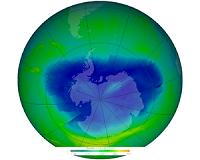| . |  |
. |
Washington (AFP) April 21, 2011 The hole in the ozone layer over Antarctica is a significant driver of climate change and rain increases in the southern hemisphere over the past 50 years, US scientists said Thursday. The findings by a team at Columbia University's School of Engineering and Applied Science are the first to link ozone depletion in the polar region to climate change all the way to the equator. Researchers said the analysis should lead policy-makers to consider the ozone layer along with other environmental factors such as Arctic ice melt and greenhouse gas emissions when considering how to tackle climate change. "It's really amazing that the ozone hole, located so high up in the atmosphere over Antarctica, can have an impact all the way to the tropics and affect rainfall there," said Sarah Kang, lead author of the study in the journal Science. "It's just like a domino effect," she said. Scientists say the Antarctic ozone hole, discovered in the 1980s, was created by the extensive use of manmade aerosols containing chlorofluorocarbons (CFCs). Since the signing by 196 countries of the 1989 Montreal Protocol, most CFC production around the world has stopped, and experts expect the hole to close by the middle of this century. "While the ozone hole has been considered as a solved problem, we're now finding it has caused a great deal of the climate change that's been observed," said co-author Lorenzo Polvani, senior research scientist at the Lamont-Doherty Earth Observatory. The study used two independently drawn climate models -- the Canadian Middle Atmosphere Model and the United States' National Center for Atmospheric Research (NCAR) Community Atmosphere Model. In four experiments comparing data on sea ice, surface temperatures, precipitation and the ozone hole, the analysis showed the hole was the main driver of heavy summer rains across eastern Australia, the southwestern Indian Ocean and the Southern Pacific Convergence Zone. "We show in this study that it has large and far-reaching impacts. The ozone hole is a big player in the climate system," said Polvani. "This could be a real game-changer." Next, the researchers plan to look at "extreme precipitation events," the sort that cause devastating floods and landslides. "We really want to know if and how the closing of the ozone hole will affect these," said Kang.
Share This Article With Planet Earth
Related Links All about the Ozone Layer
 Ozone depletion over Arctic at record level: WMO
Ozone depletion over Arctic at record level: WMOGeneva (AFP) April 5, 2011 Depletion of the ozone layer over the Arctic has reached record levels, and Nordic countries will have to watch for higher than normal ultraviolet radiation in coming weeks, the UN weather agency said Tuesday. The Arctic ozone layer suffered a loss of about 40 percent from the beginning of winter to late March, up from the previous record of about 30 percent over the entire winter, according ... read more |
|
| The content herein, unless otherwise known to be public domain, are Copyright 1995-2010 - SpaceDaily. AFP and UPI Wire Stories are copyright Agence France-Presse and United Press International. ESA Portal Reports are copyright European Space Agency. All NASA sourced material is public domain. Additional copyrights may apply in whole or part to other bona fide parties. Advertising does not imply endorsement,agreement or approval of any opinions, statements or information provided by SpaceDaily on any Web page published or hosted by SpaceDaily. Privacy Statement |